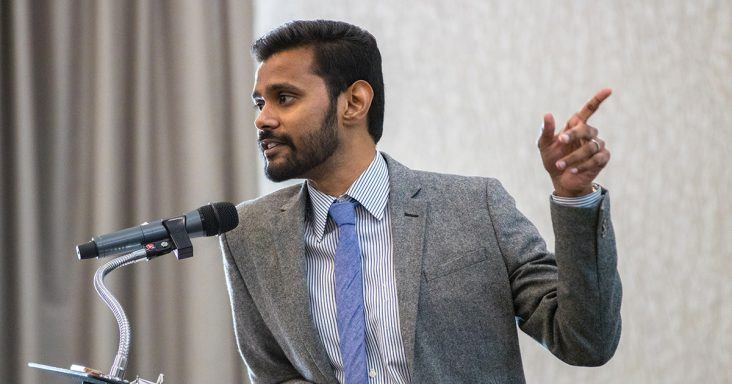Jebaraj: Inflation pressure may persist for 2 years
by May 27, 2022 3:58 pm 1,397 views

Mervin Jebaraj, director of the Center for Business & Economic Research in the Sam M. Walton College of Business at the University of Arkansas.
University of Arkansas economist Mervin Jebaraj expects U.S. GDP to rise for the remainder of the year following a 1.5% decline in the first quarter amid high inflation pressure that might last for two years.
After GDP rose by 5.7% in 2021, it fell 1.5% in the first quarter. According to Jebaraj, GDP is expected to increase by 3% in the second quarter, 2.5% in the third quarter, and 2% in the fourth quarter.
On Friday (May 27), Jebaraj presented an economic forecast during the Quarterly Business Analysis Luncheon at Hilton Garden Inn in Fayetteville. The UA Center for Business and Economic Research (CBER) hosted the event.
Jebaraj, CBER director, said the economy isn’t in a slump and noted that consumer spending and business investment remain strong. He attributed the first-quarter GDP decline to several factors, including a reduction in government spending and exports and a large number of imports.
He said the import levels show that consumers are buying goods and that the economy is driven mainly by spending on goods and services.
He said exports are lower because the U.S. economy is outperforming other countries, which have been slower to recover from the pandemic. The Russian invasion of Ukraine also affects Europe’s recovery, and China continues to struggle with the pandemic amid a zero-COVID policy, which has limited trade.
The growth outlook is positive, but he noted several headwinds for the U.S. economy, including inflation, at the highest level in 40 years.
“We’ve had significant inflation,” he said. He added that inflation was low when the United States shut down its economy at the onset of the pandemic. Globally, inflation rates are up, except for China, which has shut down its economy.
The United States has spent more than any other country to get out of the pandemic, and inflation was higher here until the Russian invasion of Ukraine. Europe has faced more inflation since the invasion.
Global food prices are rising, and if they persist, Jebaraj expects to see more refugee and immigration issues. He said a lot of food is sitting in Ukraine ports, but it’s being blockaded.
In the United States, higher prices attributed to the travel and energy sectors and used vehicles contribute to inflation. He said inflation would be temporary, but inflation pressure might be in place for two years.
He said airfares are expected to rise amid staff shortages and high fuel prices. He doesn’t expect air travel volumes to reach pre-pandemic levels again until business travel returns. The recent rise in air travel volumes can be attributed to leisure travel. Also, hotel occupancy rates remain below pre-pandemic levels. However, hotel rates are exceeding 2019 levels due to labor shortages and inflation.
He said the average U.S. worker must work for about 9 minutes to afford one gallon of gas, up from about 4 minutes at the height of the pandemic. In 2008, the workers had to work for more than 13 minutes to afford a gallon of gas.
Jebaraj expects gas prices to remain high as he doesn’t expect a near-term resolution to the invasion, an Iran nuclear deal or oil production to increase. Used car prices are expected to remain elevated amid a vehicle shortage. He said the chip shortage would contribute to a lack of used vehicles.
A labor shortage in the food manufacturing and growing sectors is contributing to higher food prices. Jebaraj said low immigration levels have contributed to the higher prices as immigrants often work on farms or in food processing. He doesn’t expect this issue to be resolved soon.
“If there’s any hope for moderating inflation, it’s going to come from us spending more money on doing things than spending money on buying things,” he said.
The Federal Reserve is working to combat inflation through interest rate increases. The first increase was 0.25%, followed by a 0.5% increase. He said the rates are expected to be increased by 0.5% two more times this year. Following this, he said the Fed would wait and see the effect of the increases before implementing more.
Mortgage rates have risen to more than 5%, but he doesn’t expect rates to hit 6% soon. Nationwide, the higher rates have started to affect home sales, but the rates have yet to significantly impact Northwest Arkansas sales.
He said new home completions might be affected because of an appliance shortage. Home and apartment vacancies remain low.
“We’ve added a ton of new apartments, and the vacancy rate is still under 3% and is under 5% in every city across Northwest Arkansas,” he said.
Nationally, he said half the increase in home prices can be attributed to remote workers. In Benton and Washington counties, home prices have risen by about 55% in the past five years. Over the same period, apartment rent has increased by about 25%.
Arkansas has about 15,000 more jobs than before the pandemic, but nearly all of those jobs can be attributed to Northwest Arkansas. He said the area’s unemployment rate is 2.2%, which is as low as it’s ever been.
Jebaraj said some people who retired because of the pandemic are starting to return to work because of inflation and are no longer concerned about the pandemic.
Still, he expects a labor shortage to persist amid staff shortages for child care, nursing homes and lower immigration levels.
